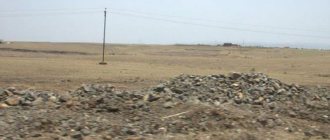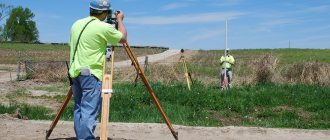The legislative framework
According to paragraph three of Art. 39 of the Federal Law “On Cadastral Activities”, not only tenants and owners of plots, but also those persons who use the land under the right of free or lifetime use can carry out the land surveying procedure within the SNT.
Before carrying out measures to measure boundaries, it is mandatory to notify neighbors along the SNT. This norm is enshrined in paragraph 8 of Art. 39 of Federal Law No. 221 “On Cadastral Activities” dated July 24, 2007.
Location, height and design features
Unacceptable fencing design between adjacent areas
On the street or driveway side, fences are most often installed along the boundary line of private land, which usually coincides with the red line on maps. Fencing on the side of the adjacent plot can be carried out both along the dividing line (in the event of such an agreement between neighbors) and on its own territory, observing all relevant norms and rules.
In the first case, the parties can jointly participate in the construction of the fence, which, from a financial point of view, is beneficial to both owners. The following recommendations apply for the implementation of fences between adjacent areas:
- height no more than 2.2 m;
- it is advisable to use light-transmitting materials (50–100% translucency) that provide a high degree of visibility;
- opaque materials (solid metal sheets, concrete, brick and others) can only be used up to a height of 75 centimeters.
But with the written consent of the owner of the neighboring plot, it is possible to deviate from the above recommendations, for example, it is possible to increase the height of a blind fence above 75 cm or use a strip of green space up to one and a half meters high as a hedge.
On the side of the red line there are fewer restrictions on streets, roads and travel. You just need to observe the maximum permitted height of 2.2 m, use structural elements that are safe for passers-by (for example, barbed wire can be placed no lower than 1.9–2 m from the ground) and be sure to coordinate the installation with the local administration.
It should also be taken into account that when the fence is located on the red line itself or at a distance closer than 1.5 meters from it, gates and entrance gates should only open into the private territory.
What is it and why do you need to divide the land?
Let's figure out why you need to do land surveying in gardening? This is because if there is no document confirming ownership rights, then other papers will not help prove your rights.
In addition, one of the main tasks of the process of surveying public land in SNT is to establish precise boundaries on the sides of the site and subsequently receive a document indicating that the land has an owner. Without this procedure, it is impossible to draw up documents for the privatization of the site.
There are cases when the land is owned by the owner without the above procedure. In this case, it turns out that without land surveying, the land cannot be registered as property, that is, from a legal point of view, it was appropriated by squatting, and this is already a violation.
Attention! Another significant advantage of carrying out land surveying in a gardeners’ association is the opportunity to receive up to 10% of excess territory, if any is available for landscaping.
Situations where a dacha plot has not been used for a long time, and then other objects are put in its place or a new owner appears, unfortunately, often occur. Such unpleasant incidents can be avoided only after complete paperwork.
As a rule, ten percent is taken from those plots whose tenants did not take care of timely registration. In favor of land surveying, we can note the fact that people who did not manage to register the land for gardening needs within the deadline set before January 1, 2020, will no longer be able to do this. Lands left without registration will be considered the property of the state.
Land surveying of a garden plot can be carried out by companies licensed to carry out such activities, or by cadastral engineers. If there is no license, this cannot be recognized as a legal distinction.
Rules for placing buildings on a garden plot
Compliance with all the listed norms on the site remains on the conscience of its owner, since by violating them, he can only cause harm to himself and his family. In addition, if the owner wants to officially register his buildings and submits the building itself and documents to the state commission to obtain permission to put it into operation, then if these standards are violated, he will most likely be denied this. True, the current legislation allows not to accept country houses and other buildings into operation, and ownership is registered only on the basis of a declaration, but the availability of such documents can play a decisive role in resolving controversial issues.
We recommend reading: If the Debtor Died and Was Disabled of Group 2 Oncology, Then the Debt is Forgiven to Him
Is this procedure mandatory in gardening?
Carrying out land surveying is not a mandatory procedure in all cases , and many gardeners are thinking about implementing it or abandoning it. This is due, first of all, to the high cost of carrying out the work and ordering the services of a special company with geodetic equipment.
The fact is that relaxations for this kind of areas are regulated by rules that are in force until January 2020. This can be read in Federal Law No. 447-FZ.
After January, any actions related to legal transactions or other procedures should be carried out only with documents on the land survey. The following facts speak in favor of this procedure:
- If we are talking about the sale of the SNT plot, it is unlikely that there will be anyone who will want to purchase the plot without a boundary plan.
- In a dispute with neighbors, you cannot do without a plan. He will help defend his rights to the land.
- If a house is planned to be built on the site, then a boundary plan is indispensable.
- After 2020, no transactions with the site will be possible without land surveying.
There is no garden plot, but there is a country house? The question is: is it necessary to survey such land?
All the answers and descriptions of the nuances of the procedure are in this article!
Structure: what parts does it consist of?
All types of boundary plans consist of a graphic and text part.
The graphic part reflects:
- site diagram on the ground;
- site boundaries;
- drawing with information about the area and other indicators;
- location of all buildings and geodetic objects.
The text part reflects the following information:
- initial data;
- on the approval of boundaries;
- about neighboring areas;
- conclusion of a cadastral engineer.
FOR REFERENCE! The boundary plan is prepared on paper and electronic media. The electronic form must be protected by a digital signature of the cadastral engineer.
Text part
The text part contains the main information characteristics of the land plot and includes the following data :
- Initial indicators on the basis of which the engineer made calculations;
- Data on what measurements and calculations were made during the process of drawing up the document;
- Data on what areas or parts of areas were formed or what changes were made to them (if any);
- Data on those plots that allow access to this site;
- Conclusion of the specialist who drew up the plan;
- An approval act signed by all interested parties (owners of adjacent plots).
Conclusion
The conclusion began to be included in the document starting in 2008 as a section of its text part.
Initially, this part of the plan was a special explanation, justification for the work carried out and how the border defining the area of the site runs.
Since 2012, such a part began to be included when necessary and it is drawn up to describe the actions performed.
It is used in situations where the definition of boundaries or any actions in the process of their installation require reference to legislative acts or certain facts to prevent the recognition of boundaries as invalid or illegally established.
Border approval act
Most of the land plots for which the specialist determines the boundaries in the process of drawing up the plan have adjacent plots directly adjacent to it.
In such situations, in order to ensure that the rights of the owners of such plots are not affected, a procedure for their approval becomes necessary.
To do this, a general meeting is held , at which the engineer presents a previously drawn up plan and clearly explains how the boundaries of the site will be drawn.
If there are no contradictions, all interested parties sign a separate document.
If all areas (or some) previously had approvals for passing boundaries, such an act may not be available .
The grafical part
The graphic part of the boundary plan is a direct display of the passing boundaries of the site, defining the boundaries of the property of a person or organization and it contains the following :
- Object diagram;
- Location of the site taking into account the accepted display scales;
- The drawing itself of the site and its parts (if there is a need to highlight the components);
- Outlines of the nodal (turning) points of the allotment, between which there are lines defining the boundaries of the property.
In what formats is it issued?
The plan is presented first on paper . The document is executed in two original copies, one of which is received by the direct customer.
Currently, in parallel, the engineer is also preparing an electronic version , which, if desired, can be separately provided to the customer who has entered into a contract for boundary work.
Legend
The following notations are accepted:
- The boundaries are determined by lines, with those that existed before cadastral work drawn in black, and those that appeared during the land surveying process in red.
- A solid line is used for boundaries whose location is determined with sufficient accuracy, and a dotted line is used with insufficient accuracy. The thickness of the lines is also regulated - 0.2 mm.
The length of the dotted line is 2 mm, the distance between them is 1 mm. Help: The required accuracy of measurements depends on the purpose of the land. For example, for gardening and individual housing construction it is 0.2 meters.
There are 4 options for marking boundaries:
- Already existing, defined with sufficient accuracy - a solid black line.
- Existing, but defined with insufficient accuracy - a dotted black line.
- Newly formed or refined, if the accuracy is sufficient - with a solid red line.
- New, but lacking in accuracy - dotted in red.
The characteristic (turning) point of the border is indicated in black:
- a solid circle with a diameter of 1.5 mm, if its location is established accurately;
- circle of the same diameter if the location is not determined precisely enough.
Land plots and their individual parts are also designated in a strictly defined way. The sections are written like this:
- Those that originally existed, from which others are formed by division, merger or redistribution - with a colon and a number from the cadastral plan. Additionally, they are highlighted by underlining and at the same time italics.
- Plots whose boundaries are being clarified or changed are marked with a colon and the number indicated in the cadastral plan.
- Formed from state or municipal lands, as well as by consolidation or redistribution - a colon, the letters “ZU” and a number.
- Formed using a section or separation from an existing one - a colon, the number of the original section, a colon, the letters “ZU” and a number.
- Multi-circuit section - with the section number and the serial number of the contour in parentheses.
And their parts are like this:
- Already existing ones - colon, number, slash and part number.
- Vanishing - the same, but using italics and underlining.
- When designating the parts being formed, “chzu” and the serial number of the part are added to the number of the land plot after the slash.
- Parts included in the composition during redistribution - the number of the original site with a colon, the letter “p” and the number of the part. If there are several such numbers, the number of the cadastral quarter is added in front (without separators).
- Included in newly formed plots (from municipal or state lands) - with a colon, the letter “p” and a number.
- When designating a part of a multi-circuit section, “chzu” and the part number are added to its number after the slash, and then, in parentheses, the contour number.
Be sure to read it! Collection of alimony debt after 18 years in 2020: sample application
Turning points are indicated:
- existing before, unchanged or with a specified location in number;
- those that have ceased to exist - with a number written in italics and underlined;
- newly formed ones - with the letter “n” and a number.
Thanks to the use of uniform symbols, not only the surveyor can understand what exactly is shown on the diagram. Anyone who knows these signs is capable of this.
What is a multi-circuit allotment?
A multi-circuit section consists of several parts - closed contours.
It comes in two types:
- consisting of separate parts (two or more);
- a plot of land with inclusions, as if “cut out” from it.
The first type is formed when it is necessary to allocate land, if it is impossible to form a whole plot of the required area. In essence, these are several plots under one cadastral number.
The second type occurs when among the lands from which the plots are allocated there are territories whose transfer to private individuals is impossible. For example, if power line supports are located on them. These “internal” territories form additional contours. Otherwise, the registration and disposal of such lands is carried out as usual, without restrictions.
The concept of “multi-circuit land plot” was introduced on March 1, 2008 with the entry into force of Law No. 221-FZ of July 24, 2007. Before this, the name “single land use” was used.
Both it and the individual parts had their own cadastral numbers. Lands registered this way retain both their numbers and name.
A boundary plan is an important document containing a lot of information about a land plot. It must be properly drawn up both when the site is formed and with any changes to its boundaries.
When is it not required?
There are some exceptions when there is no need to carry out measuring work at the SNT site. This exception recognizes the registration of land on the basis of the law on dacha amnesty .
This applies to the registration of SNT land plots, as well as individual construction. In order to become the full owner of land property, a measurement procedure is not required.
For such objects it is not necessary to carry out a land surveying procedure, but in order to avoid further disputes with neighbors, it is recommended to take measurements and draw up a new site plan.
How to survey a plot of land for free
For ordinary citizens, free land surveying is possible only with complex cadastral work on the initiative of the state. Information about the upcoming and ongoing comprehensive land surveying is published on the municipality’s website.
In this case, the owner can contact the cadastral organization indicated on the website (usually municipal) with an application to carry out land surveying of his plot free of charge. The application is written in free form, it indicates the address, cadastral number, as well as information about the owner (full name, passport details, etc.).
The reasons for applying for a free survey may be the following:
- Information about the land is not listed in the Unified State Register of Real Estate, but ownership was already registered before 1998;
- There is a documented cadastral error;
- Data about the site is available in RosReestr, but the object is not registered in the cadastral register.
In addition, free surveying is possible:
- As part of the dacha amnesty. But it would be more correct to say “free” rather than “mandatory”. Mandatory land surveying of dacha land plots was abolished back in 2007 and is not required for registration of ownership. But this will not last long - until December 31, 2020;
- Also, from June 1, 2020, amendments were made to the Land Code of the Russian Federation (Article 39.19 “Features of providing land plots in state or municipal ownership to certain categories of citizens free of charge”), according to which the procedure for free land surveying is applicable when allocating a newly formed land plot to citizens with three or more children and in need of housing (on special registration).
If you have a gardening book
So, let’s figure out whether it is necessary to survey a land plot in SNT if such a condition exists? By law, it is not necessary to carry out the procedure if you already have a gardening book.
A person must decide this issue himself, guided by the goals and needs that are intended to be carried out in relation to the site of the garden association.
If the plot is planned to be sold or separated from public use, then experts recommend carrying out land surveying work.
Legislation
Image of the permissible boundary distance between adjacent areas
The main legislative document that should be followed is the Town Planning Code of the Russian Federation. However, it contains only the most basic requirements. Most of the specific recommendations (numbers, distances, etc.) are concentrated in sanitary and fire standards. These are, first of all, the following documents:
- Building codes and regulations (SNiP) 130-02-97 - describe the acceptable layout for the development of private property.
- Construction standard SP 11-106-97 - describes the rules for drawing up, coordinating and approving design documents for the development of private property.
These documents contain guidelines of a recommendatory nature. Therefore, standards may differ in different regions. They can be clarified at the relevant government agencies at the construction site. But in general the rules are similar.
Who should carry out the procedure?
The Gardeners' Association is not obliged to take any measures to prepare documents. The responsibility for calling specialists in the field of land surveying falls on the shoulders of the owner , that is, the one who uses the SNT land plot.
If novice gardeners want to purchase a plot of land for flower beds and planting fruit and vegetable crops, experts do not recommend purchasing those plots that have not had a land surveying procedure.
This is explained by the fact that if the responsibility for the process is assigned to the new owner, he will invest significant sums, which will not please a thrifty person.
If the area is intended for gardening
There is SNiP 30-02-97, as amended on March 12, 2001, which contains all the necessary development standards that are never fundamentally changed.
All land plots must be fenced off with transparent fences to prevent shading of neighboring property. Mesh or lattice fences no higher than one and a half meters are allowed. A blind fence can be made from the side of the roadway.
The distance between the house and the neighbors' fence must be at least three meters. Measurements are taken from the base of the house to the boundary. If this is a building for household needs, the distance is one meter. The building for keeping poultry and livestock should be located no closer than four meters from the boundary. The garage should be located no closer than one meter from the fence.
The distance from the road to the fence is specified separately. The owner of the plot cannot independently determine it, because he only has the boundaries of his property. However, there are requirements that the distance from a residential building and outbuildings to the road line must be at least five meters. If this is a passage, then three meters.
Detailed information on the permitted distances between fences can be obtained from the architecture department of your locality.
Do neighbors need signatures?
Even if the owner of the plot has never seen the owners of other plots and does not know whose land is located in the adjacent territory, they need to be found, because It is required to collect signatures from neighbors . If contact between the landowners of the garden association never took place, you need to send a letter via postal service.
That is, to the question of whether this is necessary and whether it is necessary to collect signatures from neighbors in the dacha area, one can give an unequivocal answer - yes.
If there is no response to the letters, you can publish the appeal in the local newspaper. You need to wait for a response within a month, if no negative or positive response was received from the persons to whom the letter was sent, then after a month the procedure for surveying the SNT site is considered agreed upon and you can use the services of surveyors.
However, if a neighbor disagrees with the procedure, then the dispute can only be resolved in court.
If the site has no neighbors, then you can carry out the land surveying procedure according to a simplified scheme , referring to Federal Law No. 93-FZ, ed. 2020 “About the dacha amnesty.”
Of course, you can’t know everything for sure, but this option with a simplified system is only applicable if you are one hundred percent sure. If the neighbors do appear, they will begin to make claims and also accuse them of seizing their share of the plot.
Important! Experienced legal experts advise sending not one, but two or more letters in order to obtain a response.
From all of the above, we can conclude that the neighbor’s signature matters if he really exists . If the owner of the plot is sure that he is surrounded by ownerless land, then he can call surveyors, but if this turns out not to be the case, the neighbor has the right to sue the invader of his territory.
Distances between the fence and surrounding objects
Location of neighboring buildings relative to the fence
According to sanitary standards, it is necessary to maintain the minimum distance between the fence and various types of buildings, both your own and neighboring properties:
- to a residential building, cottage and others – 3 m;
- to enclosures for pets – 4 m;
- to ponds, swimming pools and other bodies of water - 3 m;
- from baths, saunas, mini-boiler houses and other fire-hazardous buildings - 5 m;
- from sheds, gazebos and other outbuildings - 4 m;
- from tall trees (apple, pear and the like) - 3 m;
- from medium-sized trees (cherry, plum and the like) - 2 m;
- from berry and ornamental bushes – 1 m.
Moreover, distances are measured from the facades of buildings, and if there are elements protruding by more than 0.5 m (porch, steps, awnings, roof slopes, etc.), measurements should be made from the protruding parts.
These requirements must be followed for your own convenience. After all, if you do not take into account the parts of the building extending beyond the façade, you may encounter the problem of too narrow a distance between the fence and the house, which will complicate movement around the territory. It is reasonable to make such deviations from the recommendations only if there is an acute shortage of space on the allocated land area.
detailed instructions
So, in order to carry out the surveying procedure, you need to go through the following stages when contacting a company that provides geodesy services. The financial cost of the work will depend on the company’s prices, but usually the price is set on an individual basis.
After contacting the company’s employees, they will offer to conclude an agreement with them, for which the following documents will be needed:
- If another person is involved in the registration procedure, he needs to have a pre-certified power of attorney and a passport.
- A document indicating receipt of ownership rights to a specific plot of land within the SNT. Such documents may include a certificate of ownership or a contract for a purchase and sale transaction, etc.
- Some companies may ask for a foundation agreement.
- Identification document of the applying owner.
Sometimes the owner of the site provides the company with:
- A certificate confirming the absence of communications belonging to the public.
Such a document can be obtained by contacting the administration of the district where the dacha plot is located. A special technician will check the plot and draw his conclusions, refuting or confirming the presence of equipment. - Certificate from the mountains. light, where it is stated that no electrical cables are laid on the territory of the land plot.
The second stage of work consists of notifying neighbors in the gardening community about the upcoming land survey. This must be done no later than a week before the proposed work. They must personally be at the survey site and monitor the progress of work.
In self-notification you must adhere to the following scheme:
- Write the text by hand and send it to each of your neighbors by mail.
- Go around the neighboring gardening plots and tell them about the upcoming event, while handing them a notification to sign.
- The engineer receives notices from the owner of the site with the signatures of the neighbors.
Form of notification of the land surveying procedure.
Notification work can be ordered from a company; the approximate cost of notifying one person will be 250 rubles. Those who have free time can do their own search for the owners of a plot in the neighborhood.
It is important to note that neighbors must be warned about upcoming work , but if for some reason they do not show up for land surveying, surveyors will begin work without them.
This is not considered a fundamental factor for refusing land surveying. The next stage will consist of measuring the boundaries of the entire garden plot and recording the results in a special land surveying act.
With each marking, neighbors will be asked whether they agree with the measurements taken or not. After the land surveying process, the act is signed by the following persons:
- the owner of the measured plot or his chosen representative;
- neighbors from adjacent SNT lands, if they participated in the measurements;
- the engineer who carried out the measuring work;
- a representative from the administration, upon notification of the company.
The last step is to visit the company on the day that will be appointed. The owner will be given a land surveying certificate after the surveying company has carried out the work.
In the event that the boundaries of the measured area have changed after measurements, you need to proceed as follows :
- The owner needs to take the act to the District Committee responsible for land resources. There it must be signed and on the day that is chosen, it can be picked up.
- After this, you need to take care of including the site in Rosreestr, and to do this you need to go to the MFC or a branch of Rosreestr.
- Pay the state fee of 1000 rubles.
- Sign the application filled out by the registrar.
- After this, the registrar will take all the documents except the identity card and issue a special certificate confirming their acceptance. On the day written in the certificate, you will need to appear to receive documents.
Main differences from the land boundary plan
A boundary plan and a boundary plan are two completely different documents.
The boundary plan reflects the current boundaries of the land plot, their features, and length.
The boundary plan reflects the very process of forming a given area with the help of lines, arrows, dotted lines and other symbols. The graphic images of these two documents are completely different from each other.
Differences from the cadastral plan
These two documents, unlike the boundary plan, are similar to each other. But you should not confuse them, since these are also two different documents. The boundary plan is a kind of continuation of the cadastral plan. The cadastral document is taken as a basis and then further changes carried out with the land plot (merger or delimitation) are schematically depicted on it. That is, it reflects further changes in the cadastral plan and supplements it.
Differences from technical
Although these two documents are also similar, they have several differences:
- the technical plan displays not only the boundaries of the land plot, but also all the buildings located on it;
- To draw up a technical plan, title documents for buildings, operating permission, etc. are required. While in order to draw up a land survey, you need data from the cadastral passport.









